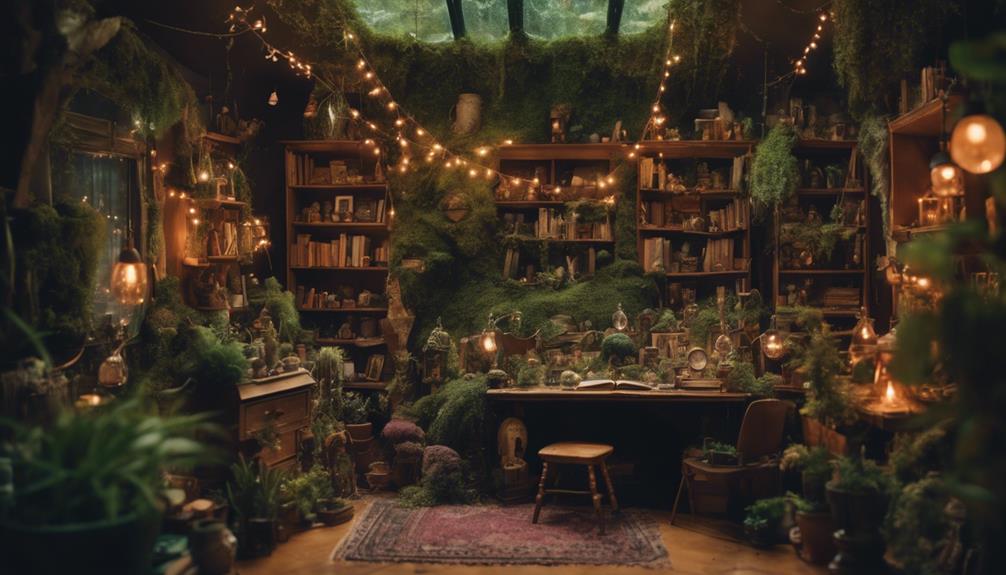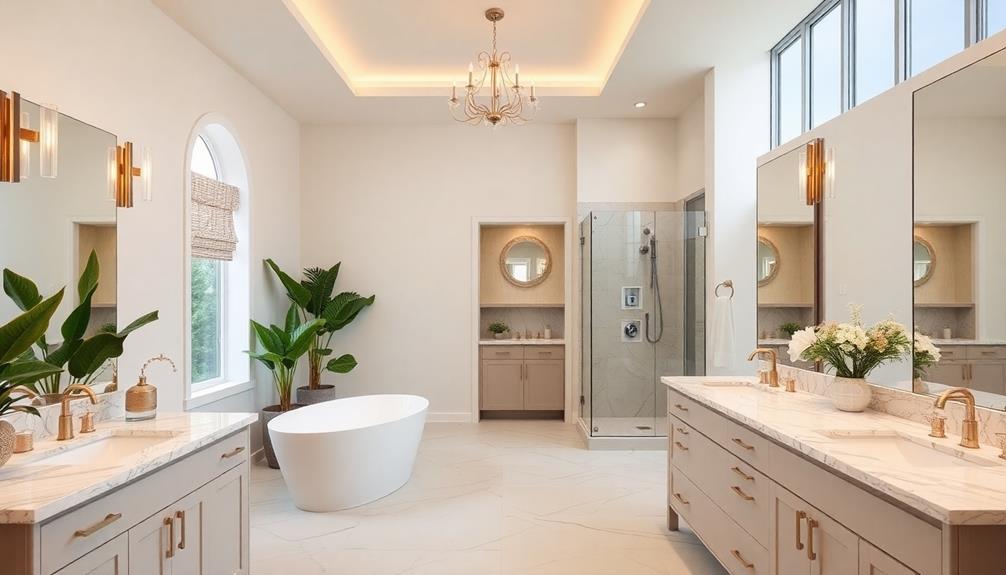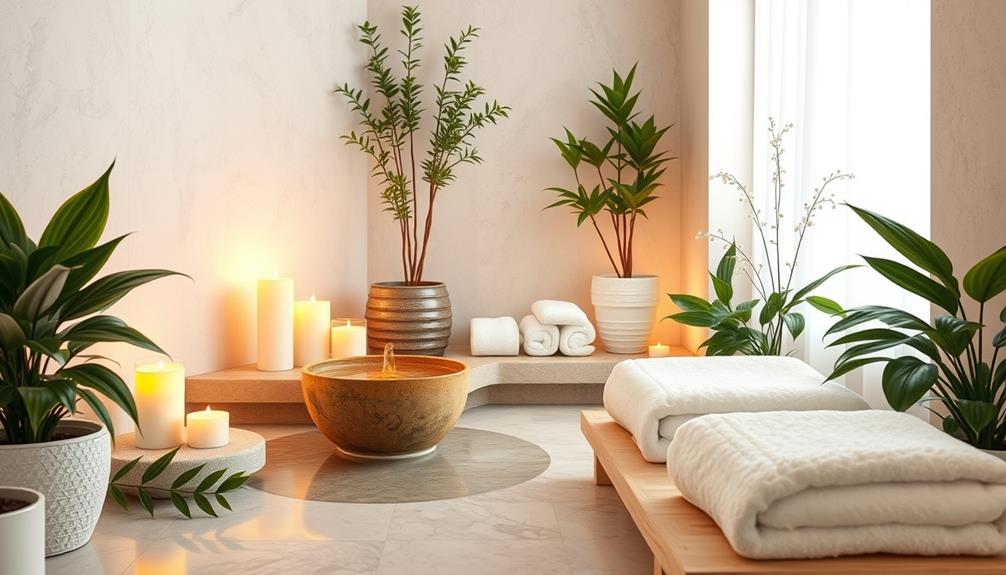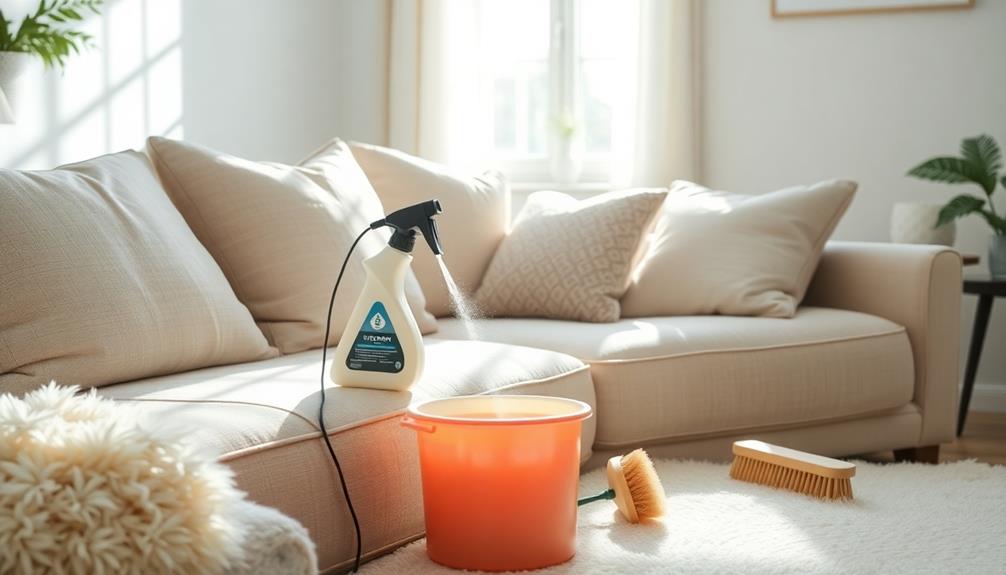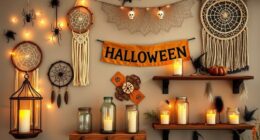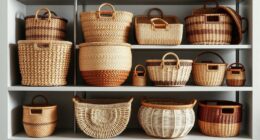To achieve a captivating goblincore room, begin by incorporating earthy tones such as deep greens and browns that capture the untamed beauty of nature. Utilize natural materials like wood and stone, while incorporating foraged items like moss and crystals to highlight hidden treasures. Consider adding a moss-covered coffee table and a vintage lantern display for both functionality and ambient lighting. Whimsical details like hand-painted ceramic toadstools or fairy doors will ignite curiosity and foster imagination. Lastly, opt for flooring that enhances the cozy, rustic atmosphere – natural wood or cork with leaf patterns are ideal choices. Discover more inspiring ideas to transform your space into an enchanted sanctuary!
Key Elements

To create a goblincore-inspired space, focus on a color scheme that reflects earthy tones, bringing warmth and depth to your room.
Choose materials like wood and stone, and incorporate textures through items like moss and feathers to enhance the natural vibe.
Color Scheme
The goblincore color scheme thrives on earthy tones like deep greens and browns, capturing the wild beauty of nature.
To create the perfect goblincore decor, focus on darker shades that evoke a cozy, inviting atmosphere reminiscent of woodland settings. These tones reflect the underappreciated aspects of nature, drawing you into a magical domain filled with enchanting visuals.
Incorporate muted metallics, such as gold or copper, to mimic the goblin fascination with shiny objects. These accents add a whimsical touch while maintaining the earthy palette.
Layering textures with natural materials like wood and stone enhances the visual appeal of your space, grounding it in the beauty of the outdoors.
Don't shy away from integrating pops of color through decor items. Vibrant mushrooms or mossy greens can bring a playful element to the design, keeping the aesthetic lively and engaging.
Materials
Natural materials form the backbone of goblincore decor, creating an earthy and inviting atmosphere that celebrates the beauty of the outdoors. To achieve this enchanting vibe, focus on incorporating elements like wood, stone, and clay into your interior design. Foraged items such as moss, sticks, and stones can enhance the organic feel of your goblincore room decor, showcasing nature's often-overlooked treasures.
Curate collections of crystals, rocks, bones, and feathers that reflect your personal interests. These trinkets lend a sense of organized chaos, adding character and charm to your space. Darker color palettes featuring shades of green and brown work well, while metallic accents can bring an unexpected whimsy.
Lighting plays a vital role in goblincore aesthetics. Use reflective surfaces to bounce light around the room, creating a warm, cozy atmosphere. Incorporate fairy lights to highlight intricate details of your decor elements, making your space feel both magical and grounded.
Textures
Incorporating a variety of textures is essential for achieving the enchanting goblincore aesthetic, as it invites tactile interaction and creates a cozy, inviting atmosphere.
Start with natural materials like wood, stone, and clay, which reflect the unconventional beauty of the goblincore style. Soft textiles, such as thick quilts and earthy-toned pillows, add layers of comfort and warmth, encouraging you to snuggle up and feel at home.
To enhance the wild and whimsical vibe, include elements like moss, foraged items, and unique ceramic pieces. These additions celebrate nature's beauty and provide delightful textures that draw the eye.
Don't forget to mix in shiny objects, like crystals and reflective decor, which catch the light and embody the goblin folklore's treasure-collecting spirit.
Essential Fixtures and Furniture

When creating your goblincore space, focus on fixtures and furniture that bring nature indoors.
A moss-covered coffee table, repurposed wooden bookshelf, and vintage lantern display stand set the perfect tone for your whimsical retreat.
These elements not only highlight your love for the natural world but also add character and charm to your room.
Moss-Covered Coffee Table
A moss-covered coffee table acts as a striking centerpiece that brings the essence of nature indoors, adding a whimsical touch to your goblincore-inspired room. This unique piece not only serves as functional furniture but also creates an enchanting atmosphere that captivates your guests.
By incorporating live moss, you introduce a dynamic decor element that thrives in humidity and indirect light, offering a vibrant, ever-changing focal point. To enhance the aesthetic, consider adding small crystals, stones, or fairy lights around the moss. These elements can elevate the overall look, creating a magical vibe that draws attention and sparks conversation.
Maintaining your moss-covered coffee table is simple; just guarantee it's watered regularly and positioned in a well-lit area to keep it healthy and lush.
Pair your moss-covered coffee table with thrifted or rustic furniture to fully embrace the goblincore aesthetic. This combination not only fosters a cozy and inviting space but also celebrates the beauty of nature in your home. With this centerpiece, you'll create an enchanting atmosphere that feels like a little slice of the forest within your living space.
Repurposed Wooden Bookshelf
Building on the enchanting vibe of the moss-covered coffee table, a repurposed wooden bookshelf brings both character and functionality to your goblincore room. Choosing reclaimed or vintage wood not only enhances the aesthetic but also aligns with the principles of sustainability. This choice reflects your appreciation for the beauty in imperfection, a key element of goblincore.
Your bookshelf can serve as a focal point, showcasing collections of natural items like crystals, rocks, and whimsical trinkets that celebrate organized chaos. To deepen the woodland feel, consider incorporating moss or small potted plants on the shelves. These elements create a strong connection to nature, which is central to goblincore decor.
Utilizing uneven or asymmetrical shelving arrangements allows for endless creative display options, echoing the playful and whimsical characteristics of the aesthetic. For an added touch of magic, drape fairy lights or incorporate shiny decorative elements on the bookshelf.
This will create an enchanted ambiance, inviting warmth and intrigue into your space while highlighting your fascination with shiny objects. Your repurposed wooden bookshelf will truly become a charming centerpiece in your goblincore sanctuary.
Vintage Lantern Display Stand
Transform your goblincore room with a vintage lantern display stand that showcases unique rustic decor and adds a touch of whimsy. These stands, often crafted from wrought iron or reclaimed wood, act as stunning focal points, drawing attention to the enchanting atmosphere you're creating. With intricate designs that resonate with earthy tones, they enhance your space beautifully.
By placing lanterns filled with fairy lights, moss, or crystals on your vintage lantern display stand, you'll create soft, ambient lighting that transforms any corner of your room into a magical retreat. Not only do these stands provide a charm that complements other goblincore decor items—like botanical prints and natural textures—but they also help you organize your space effectively. You can turn clutter into a decorative showcase of your favorite treasures, celebrating your unique decor style.
Incorporating a vintage lantern display stand is the perfect way to merge functionality with aesthetic appeal, ensuring your goblincore room feels cohesive and inviting. Embrace the rustic elements and let your personality shine through this enchanting addition!
Lighting Ideas
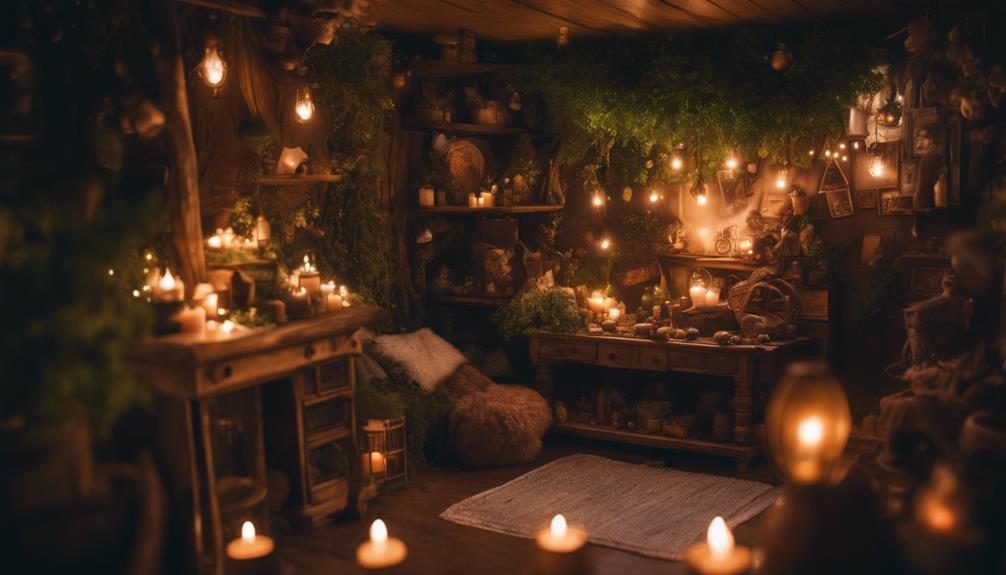
When it comes to lighting in your goblincore room, think outside the box with whimsical options like bioluminescent mushroom string lights or hanging glass terrarium lights.
You can create a magical atmosphere using glow-in-the-dark fairy lights and candlelit shadow play fixtures that add depth and intrigue.
Each lighting choice can transform your space into an enchanting retreat that reflects your love for nature and curiosity.
Bioluminescent Mushroom String Lights
Bioluminescent mushroom string lights instantly create a magical atmosphere in your goblincore-inspired space. These whimsical lights evoke the enchanting feel of magical forests, transforming any room into a fairy-tale setting. With vibrant colors and unique mushroom designs, they enhance your decor while providing soft, ambient lighting.
You'll find these string lights are typically made with energy-efficient LED bulbs, ensuring durability and versatility for both indoor and outdoor use. Available in lengths ranging from 10 to 30 feet, you can creatively arrange them to illuminate larger areas or cozy corners, making it easy to set the perfect mood.
Incorporating bioluminescent mushroom string lights into your room can draw attention to your collection of natural curiosities, like stones, plants, and other goblincore treasures. They not only light up your space but also contribute to the overall goblincore vibe, inviting a sense of wonder and whimsy.
Whether you hang them across a wall, drape them over a shelf, or string them through your plants, these lights are sure to captivate anyone who enters your enchanted oasis.
Hanging Glass Terrarium Lights
Hanging glass terrarium lights instantly create an enchanting focal point in your goblincore room, showcasing the beauty of nature while adding a whimsical glow. These unique lighting pieces enhance the goblincore aesthetic by allowing you to display plants, moss, tiny mushrooms, or even crystals within their glass confines. Not only do they serve as fascinating decor, but they also promote a cozy atmosphere that invites relaxation and wonder.
Available in various shapes and sizes, you can use these hanging glass terrarium lights as statement pieces or group them for a more dramatic effect. Incorporating LED fairy lights inside the terrariums further elevates their charm, casting a soft, inviting light that highlights the natural elements within.
Strategically placing these terrarium lights near shelves or windows can enhance their magical appeal, as they reflect off shiny surfaces, adding depth and intrigue to your space. Embrace the beauty of nature and the whimsy of the goblincore aesthetic by incorporating hanging glass terrarium lights into your room, creating a cozy and enchanting atmosphere that fascinates everyone who steps inside.
Glow-In-The-Dark Fairy Lights
Glow-in-the-dark fairy lights add a whimsical touch to your goblincore room, casting a soft glow that transforms your space into a magical haven as night falls. These enchanting lights often come in various shapes and colors, allowing you to create unique arrangements that mimic the beauty of fireflies or mystical forests. As they charge during the day, they emit a gentle glow at night, enhancing the enchanted atmosphere you desire.
String these glow-in-the-dark fairy lights across your walls, around shelves, or draped over plants to highlight your personal treasures and collections. This not only draws attention to your unique decor items but also creates a calming ambiance that complements the earthy tones found in goblincore aesthetics.
For a cohesive look, consider pairing your fairy lights with other decorative elements like botanical prints or natural materials. This combination will enhance the overall enchanted vibe of your room, making it an enthralling space for you and your guests.
With these whimsical lights, your goblincore sanctuary will truly come alive, inviting everyone to bask in its magical glow.
Candlelit Shadow Play Fixtures
Candlelit shadow play fixtures bring a cozy charm to your goblincore room, casting flickering light that dances across your walls and creates an enchanting atmosphere. Incorporate candlelit fixtures like lanterns or tea lights to enhance your space with whimsical, soft illumination. To amplify the candlelight's magical glow, use reflective surfaces such as glass holders or shiny objects, perfectly complementing the earthy tones of your decor.
Arrange candles in clusters on rustic wooden trays or mix them with natural items like moss and stones for an organized chaos that embodies the goblincore spirit. Experiment with different candle heights and sizes to create dynamic shadow play on your walls, allowing the light to produce enchanting visuals that captivate anyone who enters.
Don't forget to choose scented candles with earthy fragrances, like pine or sandalwood. These scents evoke the essence of the outdoors, deepening your connection to nature and enhancing the enchanted vibe of your room.
Decorative Elements
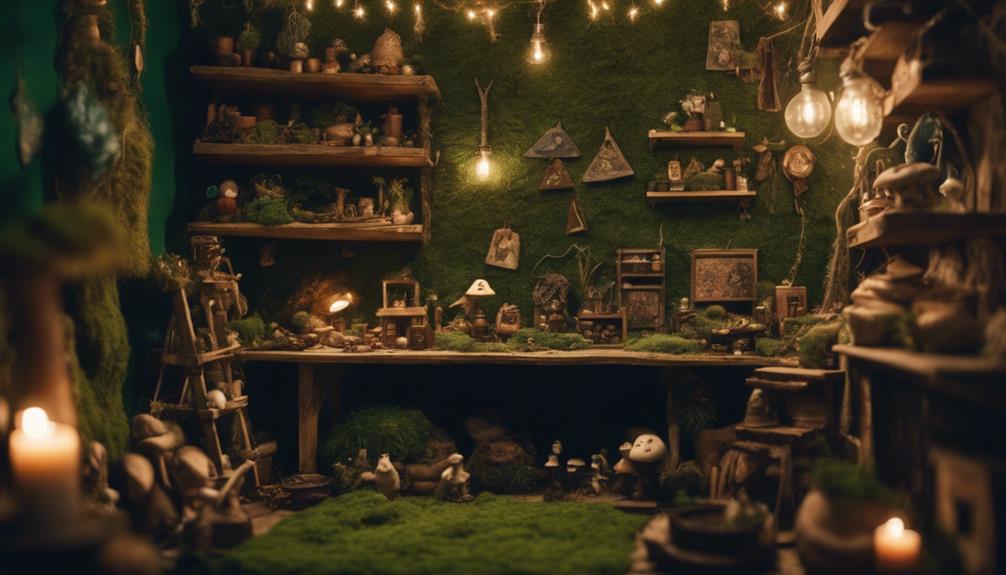
To truly capture the essence of goblincore, you'll want to include decorative elements that spark joy and whimsy.
A hand-painted ceramic toadstool figurine, a mossy stone garden sculpture, or a whimsical fairy door ornament can each add a touch of enchantment to your space.
These pieces not only reflect your personality but also celebrate the charm of nature in a unique way.
Hand-Painted Ceramic Toadstool Figurine
Hand-painted ceramic toadstool figurines bring a whimsical charm to your goblincore decor, celebrating the beauty of nature in an unconventional way.
These delightful pieces, crafted from high-quality ceramic, often showcase vibrant colors and intricate details that make them stand out as eye-catching decorative elements. Whether you place them on shelves, desks, or within terrariums, they add a playful touch to your space while harmonizing with other goblincore motifs like mushrooms and moss.
Each hand-painted ceramic toadstool figurine is typically made by artisans, ensuring that every piece possesses a unique character that resonates with the goblincore ethos of individuality and collection.
This personal touch not only enhances their appeal but also invites a sense of enchantment into your home.
Incorporating a toadstool figurine into your decor isn't just about aesthetics; it's about creating a cozy, inviting atmosphere that appeals to nature lovers and fantasy enthusiasts alike.
Mossy Stone Garden Sculpture
A mossy stone garden sculpture can instantly transform your space into a whimsical retreat, merging the allure of nature with enchanting artistry. These mesmerizing pieces serve as focal points, drawing the eye while celebrating the beauty of decay.
With intricate designs that incorporate the textures of moss and stone, mossy stone sculptures enhance your garden's earthy aesthetic, creating a serene atmosphere that invites exploration. Crafted from durable materials, these sculptures are built to withstand the elements while maintaining their enchanting appearance.
You can strategically place them in your garden or indoor decor to foster a deeper nature connection, which is essential to the goblincore aesthetic. Imagine wandering through your space, where each sculpture beckons you to appreciate the overlooked beauty of everyday life.
As you curate your goblincore haven, consider how these mossy stone sculptures can add a touch of magic and whimsy. They not only accentuate your decor but also remind you of nature's wonders, encouraging you to embrace the enchanting elements of your surroundings.
With the right placement and design, your space will become a mesmerizing retreat that celebrates the charm of the natural world.
Whimsical Fairy Door Ornament
Whimsical fairy door ornaments add a delightful touch of fantasy to your goblincore-themed room, sparking imagination and inviting exploration. These charming decorative elements serve as enchanting focal points, often crafted from natural materials like wood or clay, which perfectly align with the goblincore aesthetic that emphasizes earthy tones and textures.
You can place a whimsical fairy door in unexpected spots, like near a thriving plant or nestled among your favorite books. This placement creates a sense of wonder and encourages curiosity, making your space feel truly magical. Many designs feature intricate details such as tiny doorknobs and painted accents, enhancing their visual appeal and ensuring they become delightful conversation starters.
Incorporating a whimsical fairy door ornament into your decor not only adds character but also complements other goblincore elements, such as mushrooms and moss. By carefully arranging these pieces, you'll contribute to a cohesive, enchanted atmosphere that captivates everyone who enters your room.
Embrace the whimsy and let your imagination run wild, as these fairy doors transform your space into a charming domain that celebrates the beauty of nature and fantasy.
Flooring
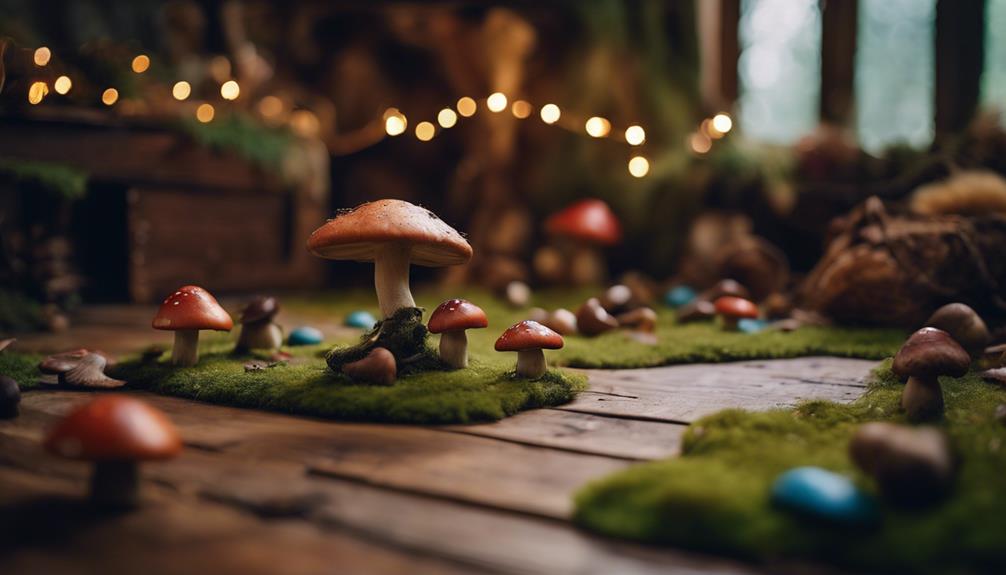
When it comes to flooring for your goblincore room, natural materials are key.
You might consider options like natural wood plank flooring for a warm, rustic vibe, or cork flooring with leaf patterns to bring a touch of nature indoors.
Reclaimed stone tile flooring can also add character and durability, perfectly aligning with the goblincore aesthetic.
Natural Wood Plank Flooring
Natural wood plank flooring brings warmth and texture to goblincore-themed rooms, perfectly enhancing the earthy aesthetic with its organic look and feel. Available in various species like oak, pine, and maple, these natural wood planks can be stained or finished to match the darker color palettes often found in goblincore decor.
Not only does wood flooring contribute to a cozy atmosphere, but it's also durable and easy to maintain, making it a smart choice for spaces centered on natural elements. The unique grains and knots in the planks add to the “organized chaos” characteristic of goblincore, giving your room a distinctive and personal touch.
When you choose natural wood plank flooring, you also improve the acoustics of your space, creating a serene ambiance that reflects the peaceful exploration of nature central to the goblincore aesthetic.
Cork Flooring With Leaf Patterns
Cork flooring with leaf patterns brings a vibrant, nature-inspired aesthetic to goblincore rooms, enhancing the earthy vibe established by natural wood plank flooring. This unique flooring option not only looks stunning but is also eco-friendly, as cork is harvested from the bark of cork oak trees without harming the trees themselves. You'll appreciate how cork flooring adds a touch of organic beauty while being sustainable.
Beyond its visual appeal, cork flooring is durable and resilient, providing a comfortable surface that absorbs sound, making your space feel cozy and inviting. The intricate leaf patterns add depth and interest to your room, beautifully complementing other natural decor elements like plants and earthy textures.
Another practical benefit of cork is its natural resistance to mold and mildew, making it an ideal choice for areas that may experience moisture. This feature supports the goblincore appreciation for nature's chaotic beauty, ensuring your enchanted space remains healthy and inviting.
Reclaimed Stone Tile Flooring
Reclaimed stone tile flooring offers a unique blend of sustainability and character, making it an ideal choice for creating a goblincore-inspired space. This environmentally friendly option repurposes materials that would otherwise end up in landfills, aligning perfectly with the ethos of goblincore. The unique textures and colors of reclaimed stone tiles add character and charm to your room, reflecting the natural, earthy tones that define this aesthetic.
Moreover, the durability of reclaimed stone tiles guarantees they can withstand the wear and tear of daily life, making them practical for spaces that celebrate the rugged beauty of nature. As you install this flooring, you'll notice how it enhances the overall ambiance of your room, creating a cozy, inviting atmosphere that complements your whimsical decor.
Each installation of reclaimed stone tile flooring is distinct, thanks to the natural variations in the stones. This means you can express your personal style while staying true to the essence of goblincore.
Embrace the beauty of reclaimed materials, and watch your space transform into an enchanted haven that captivates everyone who steps inside.
How Can I Create an Enchanted Goblincore Room with the Right Decor?
Transform your space into an enchanting Goblincore room with the right decor! Incorporate whimsical touches like vintage botanical prints, earthy tones, and cozy textures to bring the outdoors in. Get inspired by these goblincore room decor ideas and infuse your room with a magical, woodland ambiance.
Conclusion
By incorporating these goblincore room ideas, you can transform your space into an enchanting retreat that captivates everyone who enters.
Focus on key elements like earthy colors, essential fixtures, and whimsical decorative touches to create a cozy atmosphere.
Don't forget to play with lighting to enhance the magic and choose flooring that complements your theme.
Embrace your unique style, and let your imagination run wild—your goblincore haven awaits!
